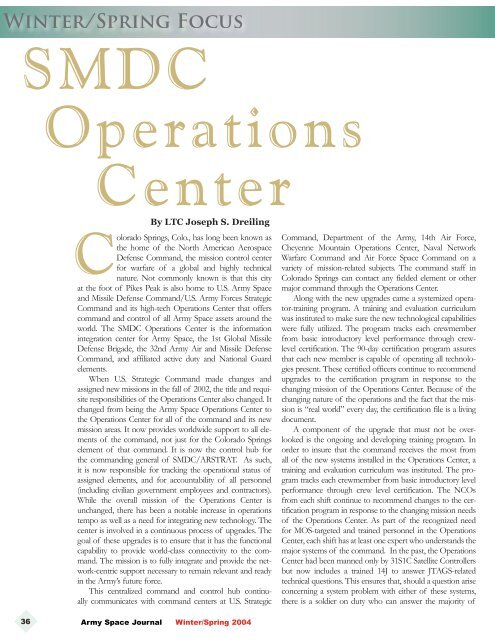Volume 3, Number 1 - Space and Missile Defense Command - U.S. ...
Volume 3, Number 1 - Space and Missile Defense Command - U.S. ...
Volume 3, Number 1 - Space and Missile Defense Command - U.S. ...
You also want an ePaper? Increase the reach of your titles
YUMPU automatically turns print PDFs into web optimized ePapers that Google loves.
SMDC<br />
Operations<br />
Center<br />
By LTC Joseph S. Dreiling<br />
Colorado Springs, Colo., has long been known as<br />
the home of the North American Aerospace<br />
<strong>Defense</strong> Comm<strong>and</strong>, the mission control center<br />
for warfare of a global <strong>and</strong> highly technical<br />
nature. Not commonly known is that this city<br />
at the foot of Pikes Peak is also home to U.S. Army <strong>Space</strong><br />
<strong>and</strong> <strong>Missile</strong> <strong>Defense</strong> Comm<strong>and</strong>/U.S. Army Forces Strategic<br />
Comm<strong>and</strong> <strong>and</strong> its high-tech Operations Center that offers<br />
comm<strong>and</strong> <strong>and</strong> control of all Army <strong>Space</strong> assets around the<br />
world. The SMDC Operations Center is the information<br />
integration center for Army <strong>Space</strong>, the 1st Global <strong>Missile</strong><br />
<strong>Defense</strong> Brigade, the 32nd Army Air <strong>and</strong> <strong>Missile</strong> <strong>Defense</strong><br />
Comm<strong>and</strong>, <strong>and</strong> affiliated active duty <strong>and</strong> National Guard<br />
elements.<br />
When U.S. Strategic Comm<strong>and</strong> made changes <strong>and</strong><br />
assigned new missions in the fall of 2002, the title <strong>and</strong> requisite<br />
responsibilities of the Operations Center also changed. It<br />
changed from being the Army <strong>Space</strong> Operations Center to<br />
the Operations Center for all of the comm<strong>and</strong> <strong>and</strong> its new<br />
mission areas. It now provides worldwide support to all elements<br />
of the comm<strong>and</strong>, not just for the Colorado Springs<br />
element of that comm<strong>and</strong>. It is now the control hub for<br />
the comm<strong>and</strong>ing general of SMDC/ARSTRAT. As such,<br />
it is now responsible for tracking the operational status of<br />
assigned elements, <strong>and</strong> for accountability of all personnel<br />
(including civilian government employees <strong>and</strong> contractors).<br />
While the overall mission of the Operations Center is<br />
unchanged, there has been a notable increase in operations<br />
tempo as well as a need for integrating new technology. The<br />
center is involved in a continuous process of upgrades. The<br />
goal of these upgrades is to ensure that it has the functional<br />
capability to provide world-class connectivity to the comm<strong>and</strong>.<br />
The mission is to fully integrate <strong>and</strong> provide the network-centric<br />
support necessary to remain relevant <strong>and</strong> ready<br />
in the Army’s future force.<br />
This centralized comm<strong>and</strong> <strong>and</strong> control hub continually<br />
communicates with comm<strong>and</strong> centers at U.S. Strategic<br />
Comm<strong>and</strong>, Department of the Army, 14th Air Force,<br />
Cheyenne Mountain Operations Center, Naval Network<br />
Warfare Comm<strong>and</strong> <strong>and</strong> Air Force <strong>Space</strong> Comm<strong>and</strong> on a<br />
variety of mission-related subjects. The comm<strong>and</strong> staff in<br />
Colorado Springs can contact any fielded element or other<br />
major comm<strong>and</strong> through the Operations Center.<br />
Along with the new upgrades came a systemized operator-training<br />
program. A training <strong>and</strong> evaluation curriculum<br />
was instituted to make sure the new technological capabilities<br />
were fully utilized. The program tracks each crewmember<br />
from basic introductory level performance through crewlevel<br />
certification. The 90-day certification program assures<br />
that each new member is capable of operating all technologies<br />
present. These certified officers continue to recommend<br />
upgrades to the certification program in response to the<br />
changing mission of the Operations Center. Because of the<br />
changing nature of the operations <strong>and</strong> the fact that the mission<br />
is “real world” every day, the certification file is a living<br />
document.<br />
A component of the upgrade that must not be overlooked<br />
is the ongoing <strong>and</strong> developing training program. In<br />
order to insure that the comm<strong>and</strong> receives the most from<br />
all of the new systems installed in the Operations Center, a<br />
training <strong>and</strong> evaluation curriculum was instituted. The program<br />
tracks each crewmember from basic introductory level<br />
performance through crew level certification. The NCOs<br />
from each shift continue to recommend changes to the certification<br />
program in response to the changing mission needs<br />
of the Operations Center. As part of the recognized need<br />
for MOS-targeted <strong>and</strong> trained personnel in the Operations<br />
Center, each shift has at least one expert who underst<strong>and</strong>s the<br />
major systems of the comm<strong>and</strong>. In the past, the Operations<br />
Center had been manned only by 31S1C Satellite Controllers<br />
but now includes a trained 14J to answer JTAGS-related<br />
technical questions. This ensures that, should a question arise<br />
concerning a system problem with either of these systems,<br />
there is a soldier on duty who can answer the majority of<br />
36<br />
Army <strong>Space</strong> Journal Winter/Spring 2004

















